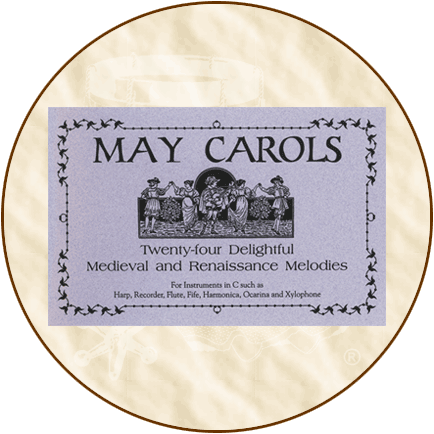.
Continued from product description
on Music Books' Page One...
Historical
Background: The Oxford Book of Carols records the history
of carols that first appeared in the 15th century. The earliest
printed collection of carols that we know of was published by
Wynkin de Worde. The word "carol" comes from the same
Greek word as "chorus," which once meant a round song
(or dance) and chorus of joy. Most people think of carols sung
at Christmastime, but there are May carols, Easter carols, carols
for the New Year, other seasonal carols (such as harvest carols),
cradle carols, and other general carols. Carols can be sacred
or secular.
Carols were very popular in England during the 16th century
until the Puritan Parliament officially abolished Christmas and
other festivals in 1647. It was not until 1822, when carols began
to be published that their popularity was revitalized.
The Furry Day Carol was originally a Cornish May carol. The
word "furry" comes from the Latin word "feria,"
which means "holiday." In Middle English, it became
known as "village fair" instead of "holy day."
Furry, derived from the Celtic word "feur," means "festival."
May carols came about during of the festivities of May Day.
Those who celebrated these festivals enjoyed singing and dancing.
Thus, their true folk poetry emerged in verse and song to accompany
these revels. Who has not heard of gathering flowers for May
baskets or dancing 'round the Maypole? In Medieval Europe, young
people would go into the woods at night, gather flowers, make
garlands, return in the morning, and take their gifts to churches
and homes for decorations while singing May carols in return
for gifts.
May baskets are a fun tradition. The First of May is celebrated
by collecting a basket of flowers and leaving it on someone's
doorstep in the morning. After quietly placing the basket, the
giver would quickly knock on the door, and then hide in order
to see the surprised expression of the person who received the
May basket.
Another May Day custom involves dancing around a maypole with
ribbons. Maypoles were originally used with ancient tree worship
by ancient Celtic tribes and were about 100 feet tall. Their
druid priests at one time condemned maypoles. The earliest known
painting featuring a maypole (or ribbon and pole dance) is The
Rotunda (May 1759) and is now on display at Ranelagh Gardens
in Chelsea, London. Today's maypoles are around 20 to 30 feet
tall. Men, women, boys, and girls decorate the maypole by dancing
around with ribbons that had been attached to the top with a
wreath of flowers.
A Medieval May Carol:
Remember us poor mayers all,
And thus we do begin
To lead our lives righteousness
Or else we live in sin
We have been rambling all the night
And almost all the day
And now returned back again
We bring you a branch of May.
Thus, with all the flowers gathered we get the saying "Bringing
in the May." Rudyard Kipling wrote:
Do not tell the priest of our plight
For he would call it sin
But we've been out in the woods all night
Conjuring summer in.
Another May Day custom is for women to go out early on May
Day and wash their faces with the morning dew to keep their youthful
beauty. The following verse was written about this practice.
The fair maid who, the First of May,
Goes to the field at break of day
And washes in the dew from the hawthorn tree,
Will ever after handsome be.
"To go a-Maying" is to gather flowers for May Day
celebrations. "Here We Go Gathering Nuts in May" is
a song and a game played in the British Isles where children
gather knots of flowers, especially from Hawthorn flowers and
the Crataegus monogyna, which bloom at the end of April. The
word "nuts" is a corruption of the word "knots."
Another May Day song is:
Summer is coming, oh, summer is near
With the leaves on the trees and the sky blue and clear
Small birds are singing their fond notes so true
And wild flowers are springing in the May morning dew.
Traditional May Day parades (featuring a May Queen and a May
King) are still held in some towns, particularly in England.
Women and little girls dress up their prettiest clothes, hoping
to be chosen the May Queen or May Lady. The horses in the parades
are even decked with garlands of May Day flowers.
Tunes such as All in a Garden Green and Merry Milkmaids found
their way into a collection of books called "The Dancing
Master," which features the instructions for the dances
as well as the tunes. One very obscure tune, Les Bouffons (a
sword dance for men), was found in a manual for marching and
drumming techniques by Thoinot Arbeau that was published in the
16th century. This manual is the only known source for the men's
sword dance as well as the Morisque and the Volt. This manual
also has early descriptions of the dances known as the gavotte,
allemande, and courante.
May Day celebrations are not as prominent in the United States
as they are in England, but we remember many of the customs that
have been handed down for generations. The music, for sure, is
fun to sing and play on a variety of instruments.













